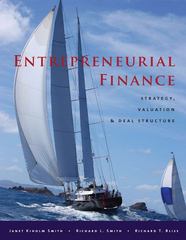Answered step by step
Verified Expert Solution
Question
1 Approved Answer
1 . Consider the following risk and return profiles for each hypothetical portfolio and the risk - free asset: Portfolio Expected returns ( in %
Consider the following risk and return profiles for each hypothetical portfolio and the riskfree asset:
Portfolio Expected returns in Beta
Riskfree
A
Market
a Based on the riskfree rate and the market returns, write the securities market line SML for all securities assuming the simple CAPM holds. Draw the SML for all three portfolios and plot portfolio A on the SML
b Based on the SML calculate the expected return for a portfolio B with Beta
c Suppose there exists another portfolio C where Beta is but the expected return is Is it possible to observe this portfolio under the simple CAPM? Why or why not?
d Continue from c calculate the implied alpha of portfolio C
e If you could choose from portfolio A and portfolio C which one would you choose, and why?
For the following questions, assume the riskfree rate is and the returns to market index is Also assume that the simple CAPM holds.
a If you buy a stock today for $ and will pay $ in dividends throughout the year, what is the price you should expect to sell it one year from now? Hint: calculate the expected returns as capital gains yield dividend yield.
b Suppose you found a zerocoupon bond a bond that does not pay any interest whose beta is equal to zero. What does it mean if the bond has a beta of zero? What is the expected return as suggested by the SML
c Continuing from b if you can receive $ on this bond a year from now, what is the price you should pay for this bond today?
d Continuing from c what should the price today be if the beta of the bond is actually Did you overpay or underpay for the bond?
For each statement below, explain whether this may be evidence against the efficient market hypothesis, and why:
a The price of Microsoft stock is unlikely to fall below $ a share.
b A professional fund manager that has outperformed the market in the past year will continue to outperform the market in the future.
c Energystock investment managers with personal connections to oil companies tend to outperform investment managers without such connections.
Briefly answer the following questions regarding the efficient market hypothesis EMH:
a Suppose you observed that returns to the S&P index in the past January have been less than the simple CAPM would suggest. Does this appear to contradict the weak form EMH? Why?
b Your friend does not believe this is evidence against weak form EMH, and actually thinks you are data mining. What does data mining mean? What could you do to test whether you indeed find a predictable pricing pattern?
c Suppose you found another phenomenon: companies that are traded less frequently tend to show positive alphas implied by the simple CAPM Which version of the EMH may be violated with this evidence? Why?
d Your friend stops you from jumping to the conclusion again. Instead, heshe argues that this actually means the simple CAPM gives us poor estimates of expected returns, as indicated by Fama and French. Briefly explain your friends argument.
Suppose an investor has the following utility function:
Returns to assets, in changes to wealth Utility
a Starting from the zero return situation, calculate the marginal utility for the investor from receiving a return of and the marginal utility from receiving a return of
b Starting from the zero return situation, calculate the marginal utility for the investor from receiving a return of and the marginal utility from receiving a return of
c Is the investor always risk averse? If not, at what returns would the investor be risk loving?
d Continue from c suppose you can sell the investor an insurance A that pays himher when the returns are or below, or an insurance B that pays himher when the returns are or below. Which asset can you overcharge the investor? In other words, which of the insurance is more likely to be overpriced, A or B
Step by Step Solution
There are 3 Steps involved in it
Step: 1

Get Instant Access to Expert-Tailored Solutions
See step-by-step solutions with expert insights and AI powered tools for academic success
Step: 2

Step: 3

Ace Your Homework with AI
Get the answers you need in no time with our AI-driven, step-by-step assistance
Get Started


